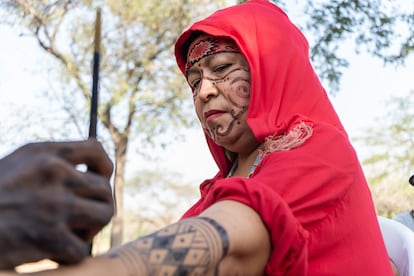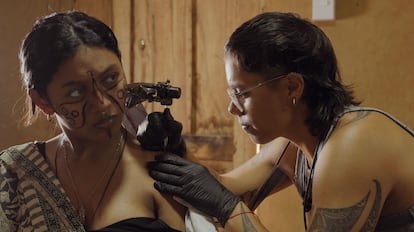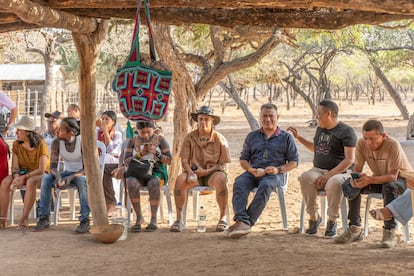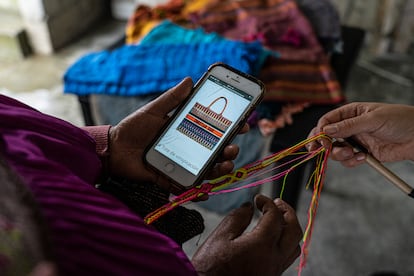Are tribal tattoos a form of cultural appropriation?
Although the dynamics of extracting symbols from Indigenous peoples are now much more subtle, experts from these communities warn that the root is the same: power relations


When Yásnaya Elena Aguilar Gil tries to put into words what cultural appropriation means, she alludes to a crude metaphor. “Let’s suppose I’m trying to kill someone, because their existence bothers me, I don’t know, I’m trying to make them disappear. And, at the same time, I realize they’re wearing a hair ornament that I really like, and I grab it, but I’m still strangling them.” For the Mexican linguist, taking that element and enriching one’s symbolic capital with it is as dangerous as the very intention of annihilating another culture. “Cultural misappropriation is the continuation of the oppression of Indigenous peoples,” she concludes.
Neither she nor David Hernández, a Wayuu leader, deny that cultural exchange has always existed. In food, sewing techniques, tattoo iconography... Cultures are the result of many interactions and learnings among equals. However, the line that divides this exchange and cultural appropriation is drawn by power relations. For the renowned Mexican researcher, collaboration between an oppressed people and its oppressor cannot exist.
Identifying cultural appropriation is a complex task, one that has traditionally been the work of anthropologists and human rights groups. However, this practice, which was once presented in a vulgar and blatant manner, is increasingly taking on nuances that complicate its association.
“It’s not the same thing when a company does it as when people with good intentions do it. The boundaries are more subtle,” Aguilar Gil clarifies. “Now there’s more talk about the phenomenon... It’s reported a lot, but it still happens.”

For Hernández, a member of the Tattooing with Thorns Collective, these blurred boundaries don’t soften the damage. He explained this at the event he organized in Bogotá last March, titled “Asho’ojushi: Ancestry in the Skin. Tattoos and Marks of Indigenous Peoples.” At the meeting, which included the participation of around 20 Indigenous leaders from various countries across the continent, including Brazil, Colombia, and Canada, demands, queries, and many questions were shared. The debate, led by tattoo artists from different communities, questioned the role of society and the way we view Indigenous peoples.
The answers to the questions about what tattoos mean to them revolve around concepts of memory, the search for water, or belonging to the land. Michel Guetio, from the Nasa community in Colombia, recounted how one of the elders in his community explained that their tattoos encompassed some 7,000 symbols, of which he himself only knew 150.
“You have to keep walking and learning,” she advised.
Kunaq Tahbone, for his part, spoke of the power of the dots in the tattoos of the Inupiaq people in Alaska. “They are usually tattooed on joints to relieve physical and spiritual pain, and negative energy.”
The practice of tattooing was relegated for decades due to discrimination against Indigenous peoples. Tahbone explained that, while several non-Indigenous tattoo artists tried to revive it, its function today has no purpose. “We are grateful for what they did, but the role of these dominant cultures is also to know how to take a step back,” he said.

The examples of cultural misappropriation are endless and commonplace: from the myriad of Polynesian tattoos, to the criticism of singer Rosalía’s use of gypsy symbols, to motifs from the Guna people of Panama and Colombia on Nike sneakers, which the brand eventually withdrew. There was also criticism in Mexico of the brand Carolina Herrera for using typical elements from some of its communities: embroidered animals like those from Tenango de Doria (Hidalgo); the colorful horizontal pattern of the sarape from Saltillo (Coahuila); or floral embroidery like that worn by Oaxacan women from the Isthmus of Tehuantepec.
In these latter cases, there’s little room for doubt because the line isn’t so blurred for experts when profit is involved. “The commodification of some of our cultural aspects is extractivist,” explains Hernández. Both emphasize the word “some.” “Because political or assembly culture, that’s not being appropriated. It only occurs with certain elements, textiles or icons that can be turned into commodities,” adds Aguilar Gil.

Who is the guardian of Indigenous cultures?
That question echoes in the minds of the Colombian filmmaker and the Mexican linguist. Aguilar Gil laments that legal frameworks — when they exist — are national, when the companies that commercialize Indigenous textiles or iconography around the world are transnational. She adds: “I don’t know if the same legal framework that has stripped peoples of their rights is the most appropriate one to protect our cultures now. Although there are very good intentions, in practice, the existing laws have no fangs, they don’t bite. I am concerned that the guardian is the Mexican government, or the states, which have been the main appropriators throughout history.”
Being a white person and wearing dreadlocks or braids; carrying or not carrying a Wayuu backpack or wearing huipiles… When asked about consumer responsibility, opinions vary widely, but they all emphasize the need for consumption to be a political act and, as such, the result of many questions. Who designed it? What does it mean to the culture to which it belongs? Why would I wear this? What connection do I have with this people? Beyond that, Aguilar Gil acknowledges that she doesn’t care much about educating consumers, since, she says, these gestures by non-Indigenous people are often justified by them as a tribute to their roots and their mixed heritage. “I’m more interested in collective responses, women weaving together an organized discourse. That’s what truly interests me, how we work together to maintain what’s ours.”
Sign up for our weekly newsletter to get more English-language news coverage from EL PAÍS USA Edition
Tu suscripción se está usando en otro dispositivo
¿Quieres añadir otro usuario a tu suscripción?
Si continúas leyendo en este dispositivo, no se podrá leer en el otro.
FlechaTu suscripción se está usando en otro dispositivo y solo puedes acceder a EL PAÍS desde un dispositivo a la vez.
Si quieres compartir tu cuenta, cambia tu suscripción a la modalidad Premium, así podrás añadir otro usuario. Cada uno accederá con su propia cuenta de email, lo que os permitirá personalizar vuestra experiencia en EL PAÍS.
¿Tienes una suscripción de empresa? Accede aquí para contratar más cuentas.
En el caso de no saber quién está usando tu cuenta, te recomendamos cambiar tu contraseña aquí.
Si decides continuar compartiendo tu cuenta, este mensaje se mostrará en tu dispositivo y en el de la otra persona que está usando tu cuenta de forma indefinida, afectando a tu experiencia de lectura. Puedes consultar aquí los términos y condiciones de la suscripción digital.
